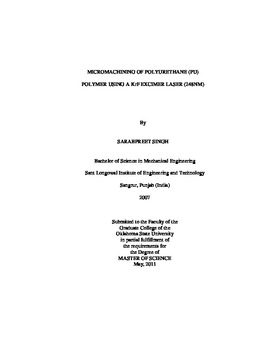| dc.description.abstract | Excimer laser micromachining has generated considerable research interest leading to numerous commercial applications in the last decade. Polyurethane (PU) polymer, due to its biocompatibility, weather resistance, and favorable physical properties, such as good flex-life, temperature resistance, electrical insulation and tear resistance finds a number of applications in medical implants, protective coatings, and as a prototype material for structural components in MEMS devices. An Excimer laser (wavelength = 248 nm, FWHM = 25 ns) is employed in this research work for micromachining of polyurethane (PU) polymer and pattern design for some potential MEMS applications. The main objective of this research is to establish a fundamental understanding of ablation mechanism in polyurethane (PU) polymer. The effect of various operating parameters, such as fluence per unit area, energy per pulse, number of pulses, repetition rates, and environment on the resulting geometries and ablation behavior are investigated. Micromachining is conducted in air and under water environments with variation in mask sizes and pattern geometries. Microgears (up to 360 μm diameter) are etched on the surface of polyurethane with several similar geometries used in MEMS devices, such as microfluidic channels, and microcircuits. It was observed that, for air environment, the ablation rate is 0.18 μm/pulse, and for underwater environment, the ablation rate is 0.07 μm/pulse (underwater ablation threshold: 0.10 J/cm<super>2</super>). The relationship was developed between wall taper angles behavior of the ablated regions with process parameters, which concluded low taper angles (~32°) for in air as compared to high taper angles (~65°) with underwater micromachining. The relationship between mask size and resulting seam quality, seam width and ablation depth for pattern generation was developed and analyzed. The experimental results for air and under water micromachining demonstrate that the ablation mechanism differs in polymers depending upon fluence (J/cm<super>2</super>), repetition rate (Hz), and working environment (in air or underwater). A combination of photo-thermal and photo-chemical ablation mechanism was attributed in the material removal process for polyurethane (PU) polymer. However, to be able to successfully and effectively produce MEMS devices, further research into the micromachining of polymers is required. | |
